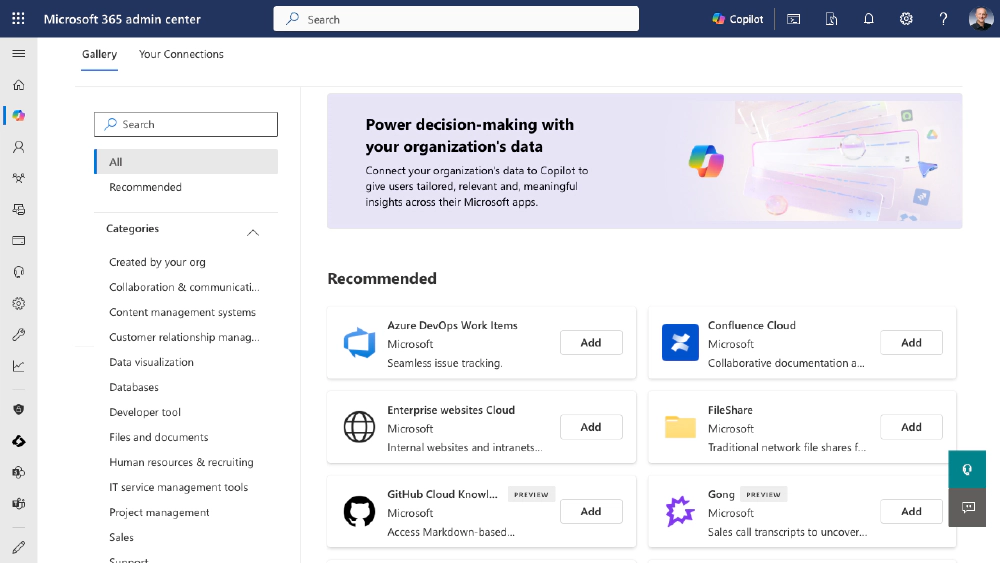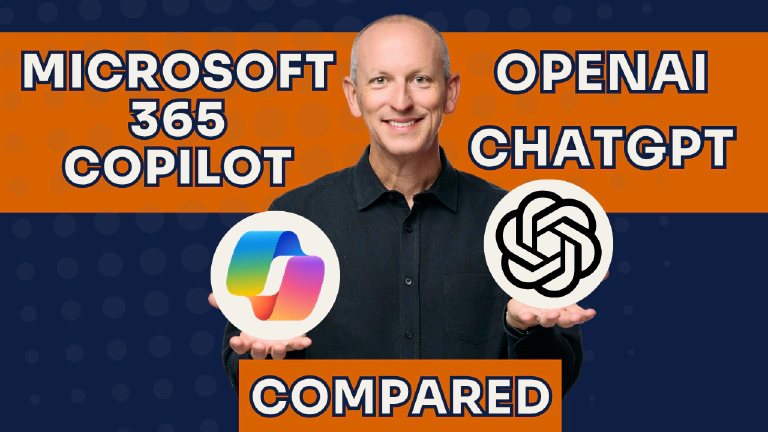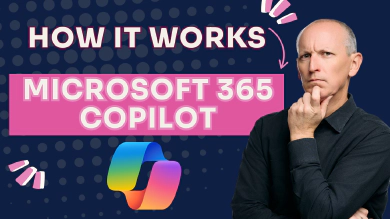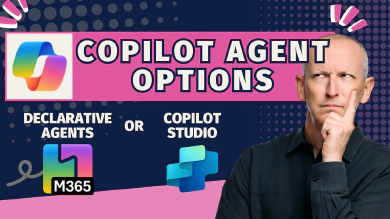Many developers ask me how Microsoft 365 Copilot (M365 Copilot) differs from ChatGPT. This question could warrant an extensive answer, but rather than sharing results from submitting research prompts to various AI platforms, I’ll offer my own HI (Human Intelligence)! 🤣
This article focuses on high-level aspects relevant to you, my readers who are primarily full-stack or pro-code developers working within the Microsoft and Microsoft 365 ecosystem.
I’ve organized what this audience needs to know into three main categories:
- data security and privacy
- how these platforms work and their key differences
- customization options available for both products
I also want to clarify what this article won’t cover.
I won’t provide an exhaustive feature comparison between Microsoft 365 Copilot and OpenAI’s ChatGPT, nor will I delve into detailed pricing discussions. Both pricing structures are well documented on their respective websites.
Platform Overview: Key Differences between Microsoft 365 Copilot & ChatGPT
Microsoft 365 Copilot is tailored for organizations with significant Microsoft 365 investments seeking a seamless deployment experience. It offers automatic compliance inheritance for security and certifications, while allowing you to leverage your existing organizational knowledge in Microsoft 365—including emails, meeting transcripts, chats, and documents stored in SharePoint and OneDrive. A standout feature is its robust data governance framework, commonly referred to as the security and compliance boundary.
In contrast, ChatGPT distinguishes itself through platform-agnostic operation and strong multi-vendor compatibility. With extensive third-party integration capabilities, it serves organizations requiring cross-platform AI solutions effectively.
Model Flexibility and Customization
The model options available within Microsoft 365 Copilot depend on your implementation approach. When using declarative agents, you’re typically restricted to Microsoft’s pre-selected models. However, Copilot Studio and Custom Engine Agents offer greater flexibility, allowing access to different models—including those available through the Azure AI Foundry model catalog that may be entirely independent of Microsoft or OpenAI.
It’s worth noting that Microsoft 365 Copilot offers consistent capabilities across applications, with only minor variations in certain specialized tools. Some limitations may apply to the consumption-based pricing plan.
Pricing Structure: Microsoft 365 Copilot
Microsoft provides three distinct payment options for Copilot. The consumption model offers unlimited usage with per-message billing, priced at $200 monthly for 25,000 messages (with the option to purchase multiple message packs). Alternatively, individual user licensing costs $30 per user monthly, providing unlimited usage without message caps. All pricing options require an underlying Microsoft 365 license.
Learn more about Microsoft 365 Copilot pricing options for businesses, enterprises, and Copilot Studio:
Microsoft 365 Copilot Plans for Business, Enterprise, & Copilot Studio
https://www.microsoft.com/microsoft-365/copilot/pricing

Pricing Structure: ChatGPT
ChatGPT offers a more diverse range of options, with varying levels of access to OpenAI’s model portfolio—including GPT-4o Mini, GPT-4.1, GPT-4.1 Mini, o3, o1-Pro, o4 Mini, and o4 Mini High.
The platform essentially presents four main pricing tiers:
- The Free Tier provides moderate response times with standard GPT-4 access (subject to limitations), capped message volumes with potential peak-hour delays, and restricted image generation capabilities.
- The Plus Plan ($20/user/month) suits individuals or small teams under 10 users, operating on shared infrastructure with other Plus subscribers. It includes standard rate limits, occasional peak-hour message caps, and access to models like GPT-4, GPT-4 Turbo, and o1 Preview.
- The Pro Plan ($200/user/month) targets groups of 10-50 users, offering unlimited access to reasoning models and GPT-4o without enterprise-level features.
- The Enterprise Plan is designed for organizations exceeding 50 users, featuring dedicated infrastructure with priority access, no usage limits, expanded 32,000 context length (versus standard limitations), and early access to advanced models including the o1 series.
Learn more about ChatGPT pricing options for from the free, plus, pro, team, and enterprise tiers:
ChatGPT pricing options: free, plus, pro, team, and enterprise tiers.
https://openai.com/chatgpt/pricing/

Data Security and Privacy
Let’s explore the critical security and privacy considerations for both platforms.
Microsoft 365 Copilot: Security Within Boundaries
Microsoft 365 Copilot offers several advanced security features:
- Comprehensive data residency options, including specialized European Union data boundary configurations
- Seamless Entra ID integration with conditional access policies
- Real-time DLP (Data Loss Prevention) enforcement
- Automatic sensitivity label application
The most significant advantage is that your data remains entirely within your Microsoft 365 boundary—often referred to as the security and compliance boundary. This means no data ever leaves the Microsoft 365 platform, eliminating external processing concerns.
ChatGPT: Flexible Global Infrastructure
ChatGPT approaches security differently with:
- Regional data residency options across seven global locations (United States, Europe, Japan, Canada, South Korea, Singapore, and India)
- 30-day deletion cycles with administrator-controlled retention policies
- Support for SAML single sign-on authentication
- SCIM (System for Cross-Domain Identity Management) integration for automated user provisioning and deprovisioning
These features create a streamlined approach to user management while maintaining security standards across different identity platforms and applications.
Understanding How AI Chatbots Work
Both Microsoft 365 Copilot and ChatGPT share a similar architectural foundation. Let’s examine their core components:
Core Architecture Layers
At the surface, there’s the user experience layer - the interface where we interact through chat or prompts. Behind this sits the orchestrator layer, which enriches your prompt with relevant contextual data before sending it to the language model.
Knowledge Sources
These AI systems leverage two primary knowledge types:
- Foundational knowledge from model training - billions of parameters built from extensive content crawling (similar to what you might learn in school)
- Supplementary knowledge gathered in response to specific prompts (comparable to looking up information you don’t immediately know)
How ChatGPT Processes Data
ChatGPT’s orchestrator enriches prompts with contextual data from external sources through connectors and integrations. This content combines with your prompt before submission to the foundational model (GPT-4, GPT-4o mini, etc.).
This approach, known as Retrieval Augmented Generation (RAG), provides enhanced context for more relevant responses.
ChatGPT’s Approach to Microsoft 365 Data
When accessing SharePoint Online or OneDrive, ChatGPT performs real-time searches against REST endpoints rather than semantic searches. This means:
- Content isn’t pre-indexed
- Relationship mapping between content is limited
- Semantic richness is reduced compared to native lookups
Even when the orchestrator accesses entire documents, it must index content on the fly - consuming more quota and tokens while potentially facing rate limiting issues and slower performance.
Importantly, this process requires your Microsoft 365 data to leave your security and compliance boundary for processing by OpenAI.
Microsoft 365 Copilot’s Semantic Index
Microsoft often describes Copilot as being “grounded in your organizational data” or “grounded in Microsoft Graph.” While accurate, the implementation details are fascinating.
Similar to how Microsoft 365 indexes documents for keyword search, a specialized indexer processes Microsoft Graph-accessible content by creating embeddings stored in a vector database - the semantic index. This capability is exclusive to Microsoft 365.
When you issue a prompt to Microsoft 365 Copilot that requires organizational information, it queries this semantic index - essentially a comprehensive vector database containing embeddings from your emails, documents, Teams messages, and more.
This approach delivers two significant advantages:
- Superior performance speed
- Inherited access controls - just like traditional Microsoft 365 search, each semantic index item has an associated access control list (ACL), ensuring Copilot only returns data you’re authorized to access
Integration and Customization Options
Both Microsoft 365 Copilot and ChatGPT offer robust integration and customization capabilities that allow developers to extend their functionality. Let’s examine how each platform approaches these critical aspects.
Microsoft 365 Copilot Integration
Microsoft 365 Copilot provides seamless integration within the Microsoft ecosystem. Once licensed, users gain immediate access to all Copilot capabilities without additional configuration. This zero-setup approach leverages Microsoft Graph integration to provide unified access to organizational data through the semantic index discussed earlier.
For developers, Microsoft 365 Copilot offers several integration paths:
- Access to 300+ Power Platform connectors for building custom agents
- API plugins implemented using the OpenAPI specification
- Copilot API endpoints for accessing underlying capabilities
ChatGPT Integration Capabilities
ChatGPT approaches integration differently, focusing on platform-agnostic capabilities:
- Comprehensive API endpoints for chat, assistants, embeddings, images, audio, and files
- 5,000+ Zapier integrations and automation platform support
- Custom GPTs with an Actions framework using the OpenAPI specification (similar to Microsoft 365 Copilot Actions)
ChatGPT Pricing Tiers & Customization Options
It’s important to note that integration capabilities vary by license tier. For example, the Plus subscription doesn’t include API access (requiring a separate subscription) and limits users to the web interface and mobile app.
Creating Custom Agents in Microsoft 365
Microsoft 365 Copilot enables developers to create specialized agents for specific business scenarios through several approaches:
Custom instructions allow developers to define system prompts that augment Copilot’s native prompts. Agents can access both knowledge indexed within Microsoft 365 via the semantic index and external knowledge sources.
External data can be integrated through numerous out-of-the-box connectors, including SQL Server, Azure DevOps, Salesforce, ServiceNow, Jira, Confluence, Monday.com, Asana, and many more. Microsoft is continuously adding more connectors, though some remain in preview.

Microsoft 365 Copilot Connectors
At the time of writing, there were over 85 Copilot Connectors in the Microsoft 365 Admin Copilot Center Connector Gallery
For platforms without native connectors, developers can create custom Copilot connectors to ingest content through Microsoft Graph, which gets indexed and added to the semantic index—making it available for Copilot queries and custom agents.
Real-time data access is possible through API Actions defined using the OpenAPI specification, similar to ChatGPT’s capabilities.
Development Tools for Microsoft 365 Copilot
Microsoft offers tools for different user personas:
- For end-users and makers: Copilot Studio provides a web-based visual designer for building agents
- For Teams users: Agent Builder offers a lightweight version of Copilot Studio integrated directly within Microsoft Teams
For developers, Microsoft provides the Visual Studio Code Microsoft 365 Agents Toolkit, enabling creation of declarative agents using text files for custom instructions and JSON/YAML files for defining knowledge sources and custom actions. More advanced scenarios are possible with Custom Engine Agents, which allow developers to implement custom orchestrators or models and control content sourcing.
ChatGPT Customization Options
ChatGPT offers similar customization capabilities, including:
- Creating and acquiring custom GPTs through the GPT Store (available with Plus subscription and higher)
- Natural language instructions and file uploads with Enterprise subscription
Enterprise subscribers gain additional capabilities focused on governance and compliance:
- Compliance APIs for audit trails
- Role-based access control (RBAC) with custom roles and permissions
Wrapping up
Both Microsoft 365 Copilot and ChatGPT deliver powerful AI capabilities, but they serve distinctly different needs and organizational contexts. Microsoft 365 Copilot excels when you’re already invested in the Microsoft ecosystem and require zero-configuration deployment with automatic compliance inheritance. Its semantic index and security boundary make it especially valuable for enterprises with strict data governance requirements.
ChatGPT stands out when you need platform flexibility, extensive third-party integrations, or access to the latest OpenAI models. Its cross-platform capabilities and mature API ecosystem make it ideal for organizations not tied to a single vendor stack.
Your choice ultimately depends on your existing infrastructure, security requirements, and development preferences. If you’re building primarily within the Microsoft 365 ecosystem, Copilot’s native integration and data handling make it a natural fit. If you need greater flexibility and model variety, ChatGPT might better serve your needs.
What questions do you have about these platforms? Have you built solutions with either one? Let me know what you think in the comments below!

Microsoft MVP, Full-Stack Developer & Chief Course Artisan - Voitanos LLC.
Andrew Connell is a full stack developer who focuses on Microsoft Azure & Microsoft 365. He’s a 21-year recipient of Microsoft’s MVP award and has helped thousands of developers through the various courses he’s authored & taught. Whether it’s an introduction to the entire ecosystem, or a deep dive into a specific software, his resources, tools, and support help web developers become experts in the Microsoft 365 ecosystem, so they can become irreplaceable in their organization.





